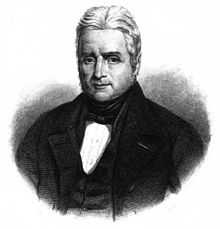Jacques Laffitte
| Jacques Laffitte | |
|---|---|
 | |
| 10th Prime Minister of France | |
| In office 2 November 1830 – 13 March 1831 | |
| Monarch | Louis Philippe I |
| Preceded by | Duc de Broglie |
| Succeeded by | Casimir Pierre Perier |
| Personal details | |
| Born | 24 October 1767 Bayonne |
| Died | 26 May 1844 (aged 76) Paris |
| Political party | Orleanist |
Jacques Laffitte (French pronunciation: [ʒak laˈfit]; 24 October 1767 – 26 May 1844) was a French banker and politician.
Biography
Laffitte was born at Bayonne, one of the ten children of a carpenter.
He became clerk in the banking house of Perregaux in Paris. He was made a partner in the business in 1800, and in 1804 succeeded Perregaux as head of the firm. The house of Perregaux, Laffitte et Cie. became one of the greatest in Europe. Laffitte himself became regent (1809), then governor (1814) of the Bank of France and president of the Chamber of Commerce (1814). He raised large sums of money for the provisional government in 1814 and for King Louis XVIII of France during the Hundred Days. It was with him that Napoleon deposited five million francs in gold before leaving France for the last time.
Rather than permit the government to appropriate the money from the bank, Laffitte supplied two million from his own pocket to cover the arrears of the imperial troops after the Battle of Waterloo. He was returned by the département of the Seine to the Chamber of Deputies in 1816, and took his seat on the left. He spoke chiefly on financial questions; his known Liberal views did not prevent Louis XVIII from insisting on his inclusion on the commission on the public finances.
In 1818 Laffitte saved Paris from financial crisis by buying a large amount of stock, but the following year, as a result of his vigorous defence of the liberty of the press and the electoral law of 1817, he lost the governorship of the Bank. One of the earliest and most determined of the partisans of a constitutional monarchy under the duke of Orleans, he was deputy for Bayonne in July 1830, when his house in Paris became the headquarters of the revolutionary party. When Charles X, after retracting the hated ordinances, sent the comte d'Argout to Laffitte to negotiate a change of ministry, the banker replied, "It is too late. There is no longer a Charles X," and it was he who secured the nomination of Louis Philippe as lieutenant-general of the kingdom. On 3 August he became president of the Chamber of Deputies, and on 9 August, he received in this capacity Louis Philippe's oath to the new constitution.
The clamour of the Paris mob for the death of the imprisoned ministers of Charles X, culminating in October riots, induced the more moderate members of the government – including Guizot, the duc de Broglie and Casimir Pierre Perier – to hand over the administration to a ministry which had the confidence of the revolutionary Parisians. On 5 November, Laffitte became minister-president of a government pledged to progress "mouvement"; he simultaneously held the portfolio of finance. The government was torn between the necessity for preserving order and the need to conciliate the Parisian populace; it succeeded in doing neither. The impeached ministers were saved by the courage of the Chamber of Peers and the attitude of the National Guard; but their safety was bought at the price of Laffitte's popularity.
His policy of a French intervention in favour of the Italian revolutionists, by which he might have regained his popularity, was thwarted by the diplomatic policy of Louis Philippe. The resignation of Lafayette and Dupont de l'Eure further undermined the government, which, incapable of keeping order in the streets of Paris, ended by being completely discredited. At length Louis Philippe, anxious to free himself from the control of the agents of his fortune, thought it safe to parade his want of confidence in the man who had made him king. In March 1831, Laffitte resigned, begging pardon of God and man for the part he had played in putting Louis Philippe on the throne. He left office politically and financially ruined. His affairs were wound up in 1836, and the following year he created a credit bank, which prospered during his lifetime, but failed in 1848. See Paul Thureau-Dangin, La Monarchie de Juillet (vol. i. 1884).
Burial Place Père Lachaise Cemetery Paris, France
References
Laffitte J., (1824), Réflexions sur la réduction de la rente, et sur l’état du crédit, 2ème édition, Paris, Galerie de Bossange Père.
![]() This article incorporates text from a publication now in the public domain: Chisholm, Hugh, ed. (1911). Encyclopædia Britannica (11th ed.). Cambridge University Press.
This article incorporates text from a publication now in the public domain: Chisholm, Hugh, ed. (1911). Encyclopædia Britannica (11th ed.). Cambridge University Press.
| |||||||||||||||||||||||||||||||||||||||||
| |||||||||||||||||||||||||||||||||||||||||
| |||||||||||||||||||||||||||||||||||||||||
| ||||||||||||||||||||||||||||||||||
|

.svg.png)